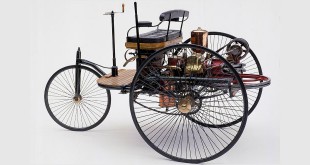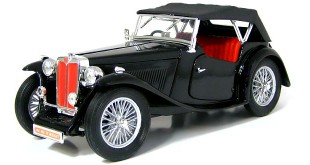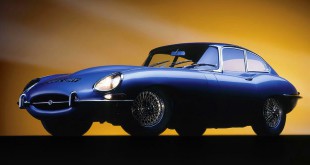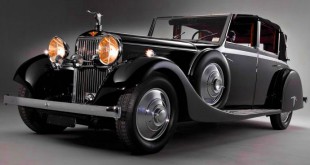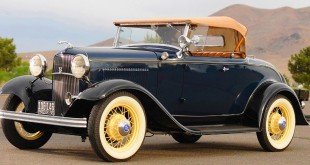Stanley Steamer —  The first Stanley Steamer (1897; United States) was a steam-powered, chain- driven buggy with a maximum speed of 40 km/h (25 mph).
The first Stanley Steamer (1897; United States) was a steam-powered, chain- driven buggy with a maximum speed of 40 km/h (25 mph).
The Stanley (nicknamed Stanley Steamer) was a steam-powered automobile produced by the Stanley Motor Carriage Company. In 1906, the Stanley Rocket set the world land speed record at 127.7 mph (205.5 km/h) at the Daytona Beach Road Course, driven by Fred Marriott, picking up the Dewar Trophy in the process. This is still officially recognized as the land speed record for a steam car. The Steamer enjoyed a boom in the early 1900s before eventually being overtaken technologically by the internal combustion engine.
History
Twins Francis Edgar Stanley (1849-1918) and Freelan O. Stanley (1849-1940) founded the company after selling their photographic dry plate business to Eastman Kodak. They produced their first car in 1897. They sold the rights to this design to Locomobile.
Early Stanley/Locomobile cars had light wooden bodies mounted on unsprung tubular steel frames by means of full-elliptic springs. Steam was generated in a vertical fire-tube boiler, mounted beneath the seat, with a vaporizing gasoline (later, kerosene) burner underneath. The boiler was reinforced by winding several layers of piano-wire around it, which gave it a tremendously strong, yet relatively light-weight, shell. In early models, the vertical fire-tubes were made of copper, and were expanded into holes in the upper and lower crown sheets. In later models, the installation of a condenser caused oil-fouling of the expansion joints, and welded steel fire-tubes were used instead. The boilers were safer than one might expect – they were fitted with safety valves, and even if these failed, a dangerous overpressure would rupture one of the many joints long before the boiler shell was in danger of bursting, and the resulting leak would relieve the boiler pressure and douse the burner with little risk to the occupants of the car. There has never been a documented case of a Stanley boiler exploding in use.
The engine had two double-acting cylinders side-by-side, equipped with slide-valves, and was of the simple-expansion type. Drive was transmitted directly from the engine crankshaft to a rear-mounted differential by means of a chain. Locomobiles were often modified by their owners, who added third-party accessories, e.g., improved lubricators, condensers, and devices which mitigated the laborious starting procedure, and so forth. Later, the Stanley brothers, to overcome patent difficulties, developed a new automobile model with twin cylinder engines geared directly to the back axle. Later models had aluminium coachwork, but retained many antiquated features, for example the unsprung tubular steel frame.
The Stanley Motor Carriage Company operated between 1902 and 1917. The cars made by the company were referred to as Stanley Steamers. When they shifted the steam boiler to the front of the vehicle, the resulting feature was called by owners the “coffin nose.” In order to improve range, condensers were used, beginning in 1915. A Stanley Steamer set the world record for the fastest mile in an automobile (28.2 seconds) in 1906. This record was not broken by any automobile until 1911, although Glen Curtis beat the record in 1907 with a V-8 powered motorcycle at 136 MPH. At first, production was limited, but it rose to 500 cars in 1917.
During the mid to late 1910s, as the fuel efficiency and power delivery of internal combustion engines improved dramatically and the usage of an electric starter rather than a crank, which was notorious for injury to its operators, also led to the rise of the gas-powered automobile (which eventually was much cheaper). The Stanley company also produced a series of advertising campaigns trying to woo the car-buying public away from the “internal explosion engine,” to little effect. An advertising slogan for these campaigns was, “Power – Correctly Generated, Correctly Controlled, Correctly Applied to the Rear Axle.” These campaigns are early examples of a fear, uncertainty and doubt type advertising campaign (for a more modern example, see Johnny Turbo), as their purpose was not so much to convince the audience of the benefits of the Stanley Steamer car as to plant the notion in the reader’s head that an internal combustion automobile could explode.
In 1917, the brothers sold their interests to Prescott Warren. The last Stanley Steamer was produced before 1927. The company endured a long period of decline and technological stagnation. As the production specifications show, no models with a power output higher than 20 hp were produced after 1918. Far better cars were available at much lower cost – for example, a 1924 Stanley 740D sedan cost $3950, compared to a few hundred dollars for a Ford Model T. Widespread use of electric starters in internal combustion cars, pioneered on production cars by Cadillac in 1912, eroded the greatest remaining technological advantages of the steam car. Efficiencies of scale, a lack of effective advertising and general public desire for higher speeds and less fussy starting than were possible with the stagnant Stanley technology were the primary causes of the company’s demise.
 Kids Portal For Parents India Kids Network
Kids Portal For Parents India Kids Network
